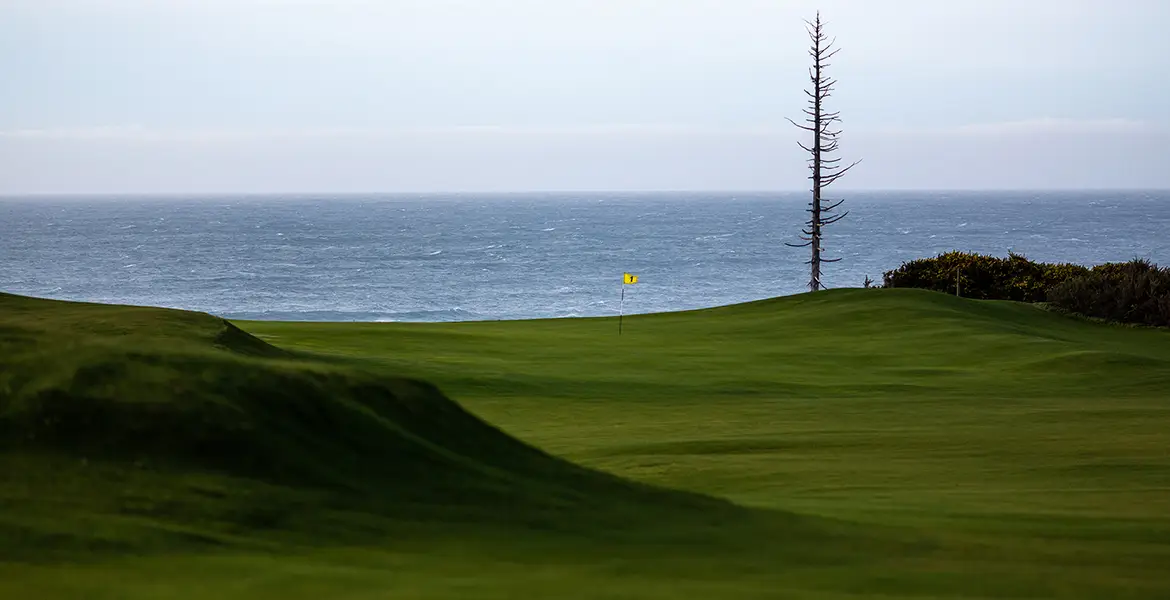Having navigated one year of writing about the importance of finding, organizing, and identifying the best set of golf holes to comprise a full golf course, it is now time to turn to the components of those holes—which bring holes to life, add flesh to the bones, and ultimately are what the vast majority of golfers relate to when discussing the perceived qualities of a golf course. These features are the greens, bunkers, tees, fairways, water hazards (yes, I still use the H-word, as it is intertwined inextricably with the traditional language of golf course architecture), and rough/native vegetation.
Back in 1928, in his book Scotland’s Gift—Golf, Charles Blair Macdonald wrote, “Putting-greens to a golf course are what the face is to a portrait. The clothes the subject wears, the background, whether scenery or whether draperies – are simply accessories; the face tells the story and determines the character and quality of the portrait – whether it is good or bad. So it is in golf; you can always build a putting green. Teeing-grounds, hazards, the fairway, rough, etc., are accessories.”

This quote has always been forefront in my mind when thinking about the features of a course and their relative hierarchy in the perception of a course’s quality. The greens are the thing!
They are frequently the first feature mentioned when it comes to the quality of maintenance, and are often the first to be lauded or criticized when it comes to the design and play of the course. As the ultimate goal for each hole is to get to the green, it makes perfect sense that they receive so much focus.
What makes a good green is a subjective definition ultimately left to the golfer. We prefer to build greens that rely more on slope than undulation for their character. When I say slope it means the tilt of the green, the way that water moves off the green, and the severity of where you can set a hole location. Slope’s influence on play is most often found in the angling or tilting of a green to be more (or less) receptive from a certain angle of play: This is one of the most relied upon strategic options available to a course architect.

The slope as it relates to putting is often created by the strategic intent of the shot as mentioned above, and then providing enough surface drainage so that water will shed off the green during a rain event. One secret to reading our greens (and most others, for that matter) is to visualize where the water runs across and off. Where water flows, so does gravity, and therefore so does a golf ball. That is not to say that our greens are devoid of undulations (humps, ridges, and hollows), but we like to use them to provide variety among the greens as opposed to relying on them on every hole. I will say that showing the restraint to rely solely on slope during the shaping of the green is not easy and undulations are much more easily recognized and impressive in the construction process. However, when we look at our favorite examples of greens they almost always rely on slope for their challenges.
My favorite set of greens is on the East Course at Merion, with those at Pine Valley and Winged Foot West running close behind. They are endlessly varied in slope, size, and undulation and perfectly sited in the landscape. I would wager a lot of money that if you asked most well-traveled golfers what their favorite greens are, they would point to greens built during the Golden Age of Golf. We, along with other modern architects, are sometimes criticized for building greens that are considered too severe for modern putting speeds. I would counter that since these older, more sloped greens are recognized as the standard for greatness in golf course architecture, shouldn’t we be trying to emulate them? I would much prefer to see the game slow down green speeds than dumb down architecture.
The most demanding greens we’ve built are at Streamsong Black, where we purposely merged them and their surrounds with the same type of turf grass, mowed at the same height. These greens have been among the most polarizing features we’ve ever built, but we are incredibly proud of their composition. We had been asked to build a course that was different from the already established Red and Blue, and to make it demanding. Jim Wagner and I decided to create a set of greens and surrounds that would match the scale of the property and also provide the main challenge to the course. We were intrigued by the idea of building green complexes that required a high level of precision to score on yet allowed the average golfer to continue playing and not lose any balls. The result of this decision provides some of the most engaging sets of putts and chips on any modern golf course.
There is no doubt that the greens at Streamsong Black are to the course as the face is to the portrait. But very much like art, the beauty of that face is in the eye of the beholder.






